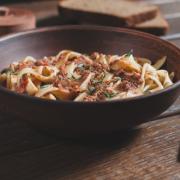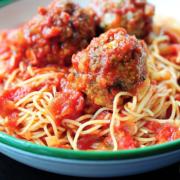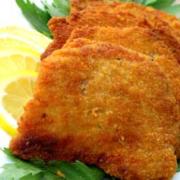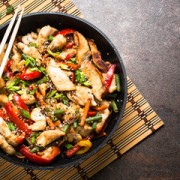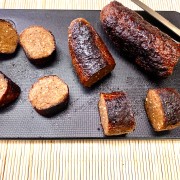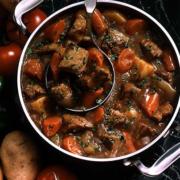Seitan
Meet Seitan, the ancient addition to the modern kitchen.

By way of, first and foremost, introduction: Seitan is an ancient Asian high protein and highly nutritious food made entirely from wheat gluten. Wikipedia gives a comprehensive description, Needless to say, Celiac and all gluten-intolerant diners need not apply (Sorry, darlings, you’re missing this party). It might be kryptonite to you, while it is a treat to the rest of us! The gluten is extracted from the wheat flour, separating all wheat starches and leaving us with only the glutinous protein, called Vital Wheat Gluten, VWG
Vital Wheat Gluten
– VWG – is very inexpensive, and the store-bought product contains no other ingredient, so my honest recommendation is, do not get zealous, especially if you are a beginner seitan tinkerer, and do not attempt to make that wheat gluten from scratch, meaning, extracting the gluten from the flour yourself. Yes, there are ways, but, umm, I’m not going there. I will push my luck only so far.
Why the Great Surge of Interest in Seitan?

To be sure, Vegan and Vegetarian eaters have been eating it forever and won’t even notice a dearth of meat and poultry if and when one occurs.
Here I am going to take the obvious easy example: Moi! I proudly and confidently call my diet 80/20: 80% plant foods, and 20% dairy, poultry, fish or meat. This is exactly what is going on in my plate at mealtime, the way we grew up eating our beloved Moroccan Food. The protein occupies 20% of the plate, with everything else plant-derived (and if the protein du jour is, say, black bean burgers, then I end up with an enviable 100% plant food plate).
Seitan as Protein
With this ratio, without even trying, I know intuitively that I never stray from a well balanced diet. And if I expand my sources of Plant Protein, even better: this is the very reason that gave me the impetus to explore more extensively with it. Tofu was the hard-to-love plant protein that came before seitan in my life, and it has been an enduring protein source, not just in cooking, but in countless desserts: my tiramisu, to take just one example among many, tells the whole story!).
Available. Inexpensive
Add to this that we are all going through dire Corona Times, when, let’s face it, fears of disruption in the food chain are not entirely unfounded or unreasonable, and some of our protein food staples might be less accessible at times. Here I don’t just mean the availability, but the quality, the variety and the prices: The long-neglected cheap and nourishing Seitanic Foods suddenly become an object of great interest, for diners across the whole diet spectrum, with the exception of gluten-restricted eaters.
The Humble Wheat Meat:
Great Performances! Name your favorites: there’s nothing I haven’t thought about, and I’m just warming up! Couscous, tajine, merguez, soup, shakshuka, piccata, bourguigon, meatballs, chicken salad, steak, burritos, curry.
Full Disclosure
Dear vegan friends, I hope this is well taken. Seitan and I, hmmm, that was not love at first sight, let alone at first bite. It started out as and all-out aversion (as in, ewww eww eww, what’s that?). Then it slowly slowly slooooowwwly evolved to – in this order – recalcitrance, resistance, reticence, reluctance, sufferance, to…. hooray, acceptance! More than that: Enjoyment! My induction period was pretty rocky, but I’m a convert now! The improbable Tofu, the other stepchild, won the battle and entered the culinary cannon quite a few years ago, so seitan should be a piece of cake by comparison!
Main Features
On the face of it, It has none of the assets that endear food to us: everything about it seems to conspire to keep us away from it. Let’s start with the name, shall we? It sounds vaguely diabolical and menacing. And it looks, how shall I put it politely, hopelessly drab. It is, to put it kindly, severely less than sexy and vibrant and attractive. As the Hebrew proverb says, Lo Re’ach Ve Lo Ta’am, unsparingly translated as, no fragrance and no flavor. This all sounds inimical to the sensuous dining experience. We need a lot of the but-it-is-delicious-and-so-good-for-you self-suggestion to the rescue.
I have been exploring extensively with Seitan, not as the Depression Food du jour, not even as the dream Save-The-Planet Plant Food, but quite simply as a delicious high quality protein in its own right to enrich and balance our diet.
The Vegan Equation
Please indulge me a moment longer. The other obstacle I have encountered with it is what I will call the philosophical factor. In other words, the unfortunate and, in my view (again: talking only for myself) decidedly inaccurate and unfair equation many vegans have tirelessly worked on imposing on the world: vegans embrace kindness and civic-mindedness in an ethical and cruelty-free world, whereas meat eaters eat anything that doesn’t move, support animal cruelty and don’t give a damn.
I respectfully cannot accept this premise
This kind and civic-minded cook and teacher, who treats the entire Food Kingdom and the Environment with the utmost respect and enthusiasm, is vexed and frankly perplexed by this simplistic and reductive logic. Daily events simply do not bear out this manufactured equation: I just don’t buy it, and the attempts to make me feel guilty about it are futile. And again, last time, that’s just me: Thank you for respecting my wishes and my right to express my opinion.
OK. Rant over. To parody Dr Ruth, I’m glad we had this little talk!
Make your own Seitan!
Most of the existing commercial brands look hopelessly unappealing, sorry, and look destined to turn us off to it; I will kindly leave this line unlinked, but it is very easy to verify. The great news is, making your own seitan is child’s play and costs pennies.
Seitan-making is a vast subject, and I will not go into all the choices: it is not the purpose of this post. I am looking to streamline it, in an obvious desire to encourage you to make it. For now, talking to my fellow Seitan Beginners Cooks, I will start with the simplest most basic Seitan preparations.
To Steam or not to Steam?
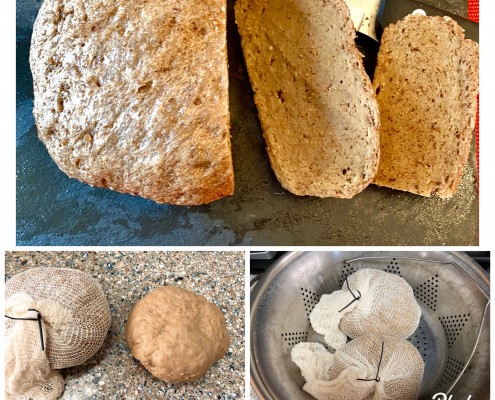
That is the question, always. You will come across many recipes that instruct you to steam, or bake, or to cook in broth. All three have their own respective merits.
After enough tinkering with all three methods, I am settling on steaming for now, in the interest of streamlining.
I love to wrap seitan dough in cheesecloth for steaming: easy and clean, with none of the aluminum foil’s controversial heritage.
I’ve been wrapping my seitan dough in these stretchable breathable REUSABLE cheesecloth bags. No rolling in foil or anything. And no mess in the steamer. I love’em!
Food processor:
if you mix your dough in a food processor, it will, in one fell swoop, grind the beans or tofu used for the dough, and knead it. But for this you need a good brand high powered food processor. Don’t try with a two bit brand, or you will risk breaking your machine. Love my Cuisinart. In the absence of a good brand food processor, blend the beans or the tofu in your blender until perfectly smooth, then mix with the VWG.
Seitan Recipes
Once we have that basic steamed seitan “dough”, we take it in any direction we like. I want to make sure the appeal is more guaranteed, so I am drawing liberally and confidently from my tried and true repertoire of beloved Moroccan, French, Asian Classics, substituting seitan for the verboten protein in the listed dish. Once you get the hang of it, play with your own favorite dishes, always starting with the basic steamed preparation.
Always check in my search box for newborn seitan recipe stars; latest babies: my mock chicken/mock beef seitan loaf; my seitan sausages; my BBQ Seitan Roast
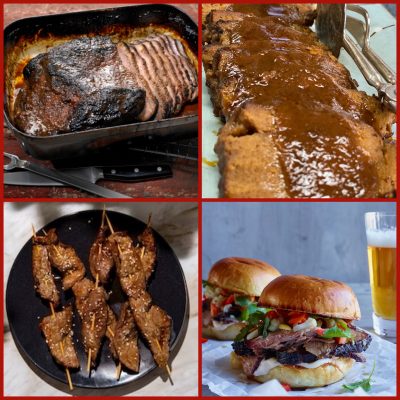
What’s in a name?
I do not look to develop or make dishes that are reminiscent of salami or roast beef or chicken or ham or steak or brisket, or any of the foods many vegans grew up with and which became verboten to them after they adopted their new philosophy and lifestyle. I get very impatient with this idea. And this is why all the Seitan dishes I develop look totally plain and sound totally generic. I am not looking to replicate anything.
I am only looking for Seitan dishes that taste terrific, that look and taste exactly like themselves, are healthy (a given), and are easy to make. So I will call them: seitan piccata, seitan bourguignon, seitan schnitzels, seitan sausages, seitan steak etc…
Unseasoned Steamed Seitan Dough
That is my starting point for most of the dishes below. That is my blank slate. The seasonings for each dish are in the dish itself, rather than in the basic dough. This is what affords me a dish with its own flavors, texture and personality each time. Other dishes call for an all-seasoned seitan dough: that is because the dough comprises most of the dish (example: seitan mock chicken loaf or meatloaf), and of course, the instructions are clear for these recipes as well.
This Basic Steamed Seitan Recipe freezes Very Well!
I am including the recipe both here and at the bottom of the post.
Don’t hesitate to double it: you’ll be happy to pull out a basic steamed seitan recipe you can use any way you like, choosing from all the dishes I have listed below.
Basic Steamed Seitan dough. Unless otherwise specified, all recipes will start with this.
Just keep in mind as a guide, depending on what you are making that day: chickpeas and other white beans in the mix will give you a light color seitan, whereas red beans and lentils will yield a dark seitan
- 1 15-ounce can chickpeas, lentils, white beans or red beans, liquid and all
- 1 1/2 cups Vital Wheat Gluten
- just a little salt, if at all: remember, your dish will likely include salt and other seasonings, so use the salt in the basic recipe sparingly
- Optional: 1/4 cup nutritional yeast, affectionately called nooch in vegan jargon. It doesn’t play any role in the texture per se, and is used mostly to impart the cheesy flavor we love in so many dishes (bolognese, piccata, spaghetti and “meat” balls
I know: you’re going to be surprised. I use nothing else unless specifically instructed, again. Because the dishes i have listed above are chock-full of their own seasonings, plenty for the seitan to soak up.
One more good seitan ingredient combo;
same method
- 1 1/2 cups VWG
- 1 1/2 cups water
- 1/4 cup chickpea or other flour.
- just a little salt, if at all: remember, your dish will likely include salt and other seasonings, so use the salt in the basic recipe sparingly
Put about 3-4 inches water in a steamer pot and bring it to a boil.
Pour the can chickpeas into a (good brand only please) food processor, with its liquid. Process until perfectly smooth. Then add the gluten and process a full 1-2 minutes, until the whole mixture comes away from the bowl of the processor, in one smooth ball.
No food processor? In the absence of a good brand food processor, blend the beans or the tofu in your blender until perfectly smooth first, then mix with the VWG by hand, and knead about 2 minutes.
Shape the ball into a loaf, like a meatloaf. Wrap it loosely, in cheesecloth (love my disposable expandable cheesecloth bags)to allow for its expansion
Place the bag in the top steamer part of the pot, making sure it never comes in direct contact with the water below. Cover and steam 30 minutes, turning the loaf on its other side mid-steaming
Turn off the flame, leave the cover on and let the loaf rest a few minutes.
Congratulations: you are now Ready to make any seitan dish you please!
One batch will yield a good 8 servings of any dish you make.
Substitute coarsely ground steamed seitan for beef, and proceed with the recipe as instructed.
Add cubed basic steamed seitan to the recipe at the beginning, and proceed with the recipe as instructed.
Add cubed basic steamed seitan to the vegetarian recipe variation at the beginning, and proceed with the recipe as instructed.
Substitute basic steamed sliced seitan for chicken, and proceed with the recipe as instructed.
Grind the basic steamed seitan, and proceed with the recipe. Add a little flour if necessary for the wheat balls to keep their shape.
Substitute sliced steamed seitan for chicken, and proceed with the recipe as instructed.
Substitute seitan for chicken, and proceed with the recipe as instructed.
Substitute seitan for tofu, and proceed with the recipe as instructed.
Substitute seitan for tofu, and proceed with the recipe as instructed.
Use the sliced steamed basic recipe. Cut it in strips and proceed with the recipe.
Substitute diced steamed seitan for the eggs, using it at the beginning of the recipe.
Substitute diced steamed seitan for the chicken.
Substitute diced steamed seitan for the beef.
Add ground or diced steamed seitan to the recipe.
Substitute diced steamed seitan for the beef.
Make your basic seitan dough normally as instructed. (See the recipe for more information)
Use cubed basic steamed seitan. The initial time of cooking the beef or chicken first doesn’t apply, and is eliminated. All ingredients aboard, and cook for about one hour. Crockpot or instant pot OK too, at low temp.
Use the sliced steamed basic recipe. Let them marinate in your favorite marinade, a couple hours and even overnight to get them ideally tender. Drain the marinade and sear the steaks, 2-3 minutes on each side.
Ingredients
Basic Steamed Seitan dough. Unless otherwise specified, all recipes will start with this.
Just keep in mind as a guide, depending on what you are making that day: chickpeas and other white beans in the mix will give you a light color seitan, whereas red beans and lentils will yield a dark seitan
- 1 15-ounce can chickpeas, lentils, white beans or red beans, liquid and all
- 1 1/2 cups Vital Wheat Gluten
- just a little salt, if at all: remember, your dish will likely include salt and other seasonings, so use the salt in the basic recipe sparingly
- Optional: 1/4 cup nutritional yeast, affectionately called nooch in vegan jargon. It doesn’t play any role in the texture per se, and is used mostly to impart the cheesy flavor we love in so many dishes (bolognese, piccata, spaghetti and “meat” balls
I know: you’re going to be surprised. I use nothing else unless specifically instructed, again. Because the dishes i have listed above are chock-full of their own seasonings, plenty for the seitan to soak up.
One more good seitan ingredient combo;
same method
- 1 1/2 cups VWG
- 1 1/2 cups water
- 1/4 cup chickpea or other flour.
- just a little salt, if at all: remember, your dish will likely include salt and other seasonings, so use the salt in the basic recipe sparingly
I love this mixture too, but i found that it makes the cleaning of the bowl something of a drag. Still if you go with it, clean the bowl by rubbing the contours with flour to detach the gluten off the bowl.
Seitan base cooked in broth
Here i will share Bob’s Red Mills perfect and perfectly streamlined recipe https://www.bobsredmill.com/blog/recipes/meatless-mondays-basic-seitan/
Instructions
Put about 3-4 inches water in a steamer pot and bring it to a boil.
Pour the can chickpeas into a (good brand only please) food processor, with its liquid. Process until perfectly smooth. Then add the gluten and process a full 1-2 minutes, until the whole mixture comes away from the bowl of the processor, in one smooth ball.
No food processor? In the absence of a good brand food processor, blend the beans or the tofu in your blender until perfectly smooth first, then mix with the VWG by hand, and knead about 2 minutes.
Shape the ball into a loaf, like a meatloaf. Wrap it loosely, in cheesecloth (love my disposable expandable cheesecloth bags)to allow for its expansion
Place the bag in the top steamer part of the pot, making sure it never comes in direct contact with the water below. Cover and steam 30 minutes, turning the loaf on its other side mid-steaming
Turn off the flame, leave the cover on and let the loaf rest a few minutes.
Congratulations: you are now Ready to make any seitan dish you please!
One batch will yield a good 8 servings of any dish you make.

